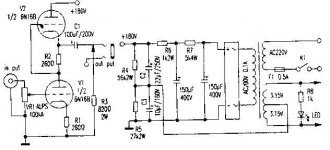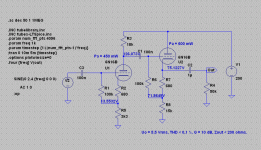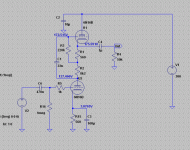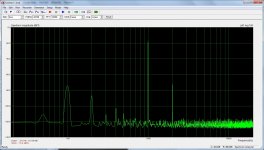Hi Everyone!
I am generally a solid state guy, but based on recent experiments I've decided to build a simple line stage for my SS power amp, its gain being marginal for what I need. I acquired 4 pcs. of 6N16B submini dual triodes, also found some circuits for them here and there, so what I am asking, has anyone experience with these tubes, ie. best config, supply voltage, anode current, etc.. What I need is a gain of 5-10X, and possibly simple construction. Input imp. of power amp is around 30 kOhm.
Thanks: Andrew
I am generally a solid state guy, but based on recent experiments I've decided to build a simple line stage for my SS power amp, its gain being marginal for what I need. I acquired 4 pcs. of 6N16B submini dual triodes, also found some circuits for them here and there, so what I am asking, has anyone experience with these tubes, ie. best config, supply voltage, anode current, etc.. What I need is a gain of 5-10X, and possibly simple construction. Input imp. of power amp is around 30 kOhm.
Thanks: Andrew
Gain of prestage 6N16B is about 30 and connecting to input of Your SS will cause very high level for input. You will rotate Your input poti for a small degree. Connecting new poti is not good idea. Every small humm will increase. Better, if Your SS has input to output power stage, connect to them with poti for volume control. If gain 6N16B doesn't enough, make two stage tube preamp. This will give You possibility to avoid hundreds passive components, that decrease quality of sound of SS prestage. Note, filtering of tube prestage will be precise, with CLC filter. /I don't like SS regs, that are brakes for dynamic/.
Last edited:
This is one alternative. Voltage amplifying stage with negative feedback to adjust the gain and improve linearity combined with a cathode follower to get the low output impedance.
R4 = 50k is a simulated load resistance and should be some 220k...470k with actual circuit.
Gain and THD values are printed on the schematic.
R4 = 50k is a simulated load resistance and should be some 220k...470k with actual circuit.
Gain and THD values are printed on the schematic.
Attachments
Last edited:
Too high gain as a linestage (> 20 dB) and THD about 3...4 times bigger than the uppermost example has.
A part of the tube sound is harmonic distorsion. The schematic i have posted has the right amount of distorsion. it just sounds good if the audiopath after the preamp is solid state with low distorsion. Place the volume adjuster before the preamp schematic.
Attachments
Last edited:
If you have harmonic distortion, then you also have intermodulation distortion and that does not sound good.
How about those 100 Hz and 200 Hz hum. Are these part of the good sound ?
How about those 100 Hz and 200 Hz hum. Are these part of the good sound ?
Last edited:
Respectfully I disagree, I'm not looking for an effects processor when I design my tube electronics, so for me there is no "tube sound" - just the sound of a fairly linear device correctly employed.
The 6N16B is a very linear tube. I recently built a balanced amp with these, 0.2W no NFB. Really good, it's my new workhorse.
Like many have said here, preamp shouldn't have too much gain. But why not build a small integrated amplifier with these tubes?
One thing I found is that these seem to have quite a lot of grid current. They benefited quite significantly from driving the grids with source followers. The balanced output tubes' grids that is, not the SE front end. Smaller signals there.
Like many have said here, preamp shouldn't have too much gain. But why not build a small integrated amplifier with these tubes?
One thing I found is that these seem to have quite a lot of grid current. They benefited quite significantly from driving the grids with source followers. The balanced output tubes' grids that is, not the SE front end. Smaller signals there.
So to summarise my rambling; I suggest you consider driving the grids with MOSFET source followers for best results. Easy and cheap.
Respectfully I disagree, I'm not looking for an effects processor when I design my tube electronics, so for me there is no "tube sound" - just the sound of a fairly linear device correctly employed.
Indeed the best amps by people like Allan Wright have almost no distortion and they are some of the most highly rated amps available.
They achieve this by using linear tubes in the most linear way and then not applying any feedback with the result of not introducing higher order distortion into the mix.
Transistors are just to unlinear to achieve these results and always haver to much gain which then needs reducing with feedback.
Shoog
- Status
- Not open for further replies.
- Home
- Amplifiers
- Tubes / Valves
- 6N16B triodes: asking advice




